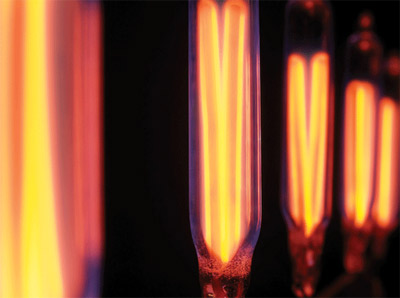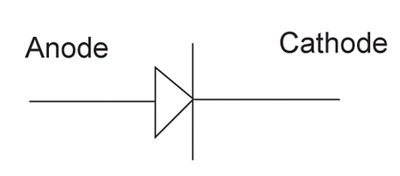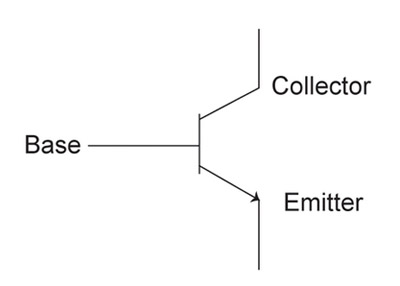We learned about fundamental atomic theory in the January issue. Protons and neutrons reside in the nucleus. Electrons revolve in orbits or more appropriately “shells” with different levels of energy around the nucleus. These electrons in the outermost valence shell are what we are interested in for our study of electronics.

Vacuum tubes operate on a principle known as thermionic emission
The definition of an electronic component from Mc-Graw-Hill’s Dictionary of Scientific and Technical Terms is as follows: “A component which is able to amplify or control voltages or currents without mechanical or other nonelectrical command, or to switch currents or voltages without mechanical switches; examples include electron tubes, transistors, and other solid-state devices.” Any study of electronics should include at least an introduction to vacuum tube theory. Solid-state device physics and the corresponding mathematical models allow for analysis of BJTs (bipolar junction transistors), FETs (field effect transistors), MOSFETs (metal oxide semiconductor field effect transistors, and CMOS (complimentary metal oxide semiconductors).
By definition current is the flow of electrons through a conductor. The vacuum tube controls the flow of electrons in a vacuum. A mechanical analogy would be how a water faucet controls the flow of water. It is interesting to note that in England vacuum tubes were called valves noting the similarity in function between what the electronic version does and what the mechanical version does. Vacuum tubes operate on a principle known asthermionic emission. By introducing thermal energy into metal atoms, electrons are emitted and this emission results in the flow of electrons into the surrounding space. A vacuum tube is a glass envelope with practically all the air evacuated from it. Inside the glass envelope are elements that emit electrons (cathode or heater), elements that receive electrons (anode or plate), and elements that control the flow of electrons (grid). A vacuum tube that contains two elements is called a diode and contains a cathode and plate. A vacuum tube that contains three elements is called a triode and contains a cathode, grid, and plate. A vacuum tube that contains four elements is called a tetrode and contains a cathode, control grid, screen grid, and plate. A vacuum tube that contains five elements is called a pentode and contains a cathode, control grid, screen grid, suppressor grid, and plate. Diodes perform the function of rectification where an incoming ac waveform is converted into either a half wave or full wave dc signal which is very useful in power supply applications. Triodes, tetrodes, and pentodes perform the functions of amplification, oscillation, and switching useful in a multitude of electronic applications. Figure 1 shows the schematic symbols for a diode and a triode.

Figure 1. Vacuum tube diode and triode
The era of solid-state electronics began in 1947 with the invention of the transistor junction at Bell Labs by three physicists, namely, John Bardeen, William Shockley, and Walter Brattain. Aconductoris a material that conducts electrical current very easily. Examples of conductors are gold, silver, copper, and aluminum. Aninsulatoris a material that does not conduct electrical current very easily. Examples of insulators are glass, porcelain, rubber, and mica. Asemiconductoris a material that behaves like something in-between an insulator and a conductor. Silicon and Germanium are examples of semiconductors.
Semiconductor materials are poor conductors and have little value in their intrinsic or pure state. When impurities are added to these materials through a process known as doping, we can create two new extrinsic or impure materials called n-type and p-type semiconductors. The familiar P-N junction diode is an electronic component that is fabricated when p-type material is combined with n-type material. It has two elements namely the anode and cathode.

Figure 2. P-N junction diode
Three terms you will hear in your study of solid-state devices areholes,electrons, andbiasing. Think of holes as a positively charged carrier, and electrons as a negatively charged carrier. Biasing is what polarity of voltage is applied to the device. An ideal P-N junction diode that isforwardbiased will conduct current from anode to cathode. An ideal P-N junction diode that isreversedbiased will block current from anode to cathode. Theoretical device physics is a very complex subject but things can be greatly simplified by thinking of a p-type material as having a majority of holes and a minority of electrons. An n-type material would have a majority of electrons and a minority of holes. Figure 2 shows the schematic symbol for a P-N junction diode.
The NPN BJT (bipolar junction transistor) is a device that is fabricated with n-type material, p-type material, and n-type material. The PNP BJT is a device fabricated with p-type material, n-type material, and p-type material. The bipolar junction transistor has three elements the emitter, base, and collector. The transistor has the ability to amplify a signal as in the case of an audio amplifier, function as a switch in the case of a digital logic circuit, and function as an oscillator in the case of an RF (radio frequency) oscillator. Please note that an oscillator is a circuit where the output (negative feedback) is fed back into the input to perform a function. Figure 3 shows the schematic symbol for an NPN BJT.

Figure 3. NPN bipolar junction transistor
Solid state devices have allowed for the technological innovations we have witnessed in the past sixty plus years. All of the devices we sometimes take for granted like television, radio, computers, and the internet were born out of the electronics age. It is revealing to study the length of time it took transportation to evolve in stages from the horse and buggy, to the steam engine, and finally to the internal combustion engine. Electronics has evolved more rapidly from the early twentieth century to the present day. Nanotechnology and further developments in device miniaturization will surely add higher levels of technology that today are only viewed as ideas.











Find Us on Socials